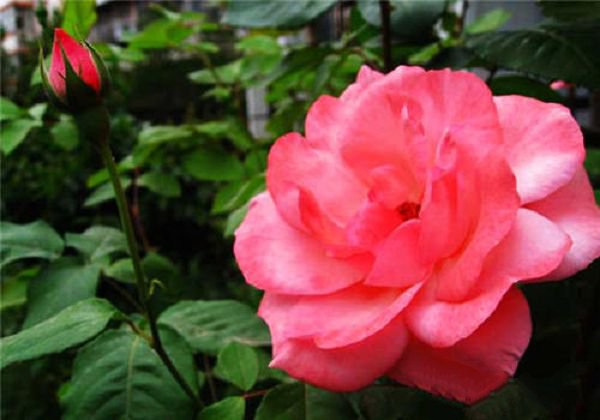Striping Propagation Technology of Flowers
1. Striping is defined as burying a section of the branch growing on the mother plant in the soil, taking root and cutting off the mother plant to make it an independent new plant. This method is mostly used for flowering shrubs with stem nodes and internodes that are easy to take root naturally or woody flowers that are not easy to take root by cutting or grafting.
Advantages: it is easy to survive, the method is simple, and the branches that are not alive can be pressed again in the coming year without wasting breeding materials.
Disadvantages: the body of seedlings can not be thoroughly renewed, the growth is not prosperous, and the production of seedlings is the least, so it is not suitable to be used in the production of a large number of seedlings.
two。 Methods (1) ordinary striping method this method is divided into single branch crimping method, continuous crimping method and wavy striping method.
① single branch striping method: this method is mainly used for tree flowers, such as peach blossom, peach blossom, plum blossom, begonia, magnolia, bauhinia, vertical silk begonia and so on a small amount of reproduction, you can use the overgrown branches on the trunk for single-branch striping reproduction (only long branches are very long, and relatively soft and easy to press on the ground).
When pressing, the 2012 branches or long branches of the mother plant close to the ground are bent downward, and then the bent part is scratched or skinned in rings. If there are conditions, you can smear the NAA of 2000x10-6, then bury it in the soil (about 15cm deep), and fix the part of the pressed branches in the soil with hooks. At the same time, the tips of the pressed branches are exposed to the ground, and fixed with bamboo poles to make them grow upright. After the cut part takes root, it can be cut off from the mother plant and planted separately.
② continuous striping method: this method uses Ding honeysuckle, crape myrtle, Parthenocissus, wood incense, Lingxiao, grapes and other vine flowers. These flowers and trees have strong rooting ability, they will take root naturally when they encounter wet soil, and the axillary buds of internodes can sprout and shoot upward at the same time.
When pressing, gently cut the nodes of the branches near the ground on the mother plant, and then bury the injured parts in the trenches dug beforehand, the depth should not exceed 3 cm, so that the tips of the branches are exposed to the ground. After a period of time, the nodes buried in the soil can sprout new roots, and soon the axillary buds on the nodes will also sprout out of the soil surface. After the seedlings are ripe, they can go deep into the soil layer with a sharp knife, cut off the internodes of each segment, and can be transplanted after more than half a year of cultivation.
③ corrugated striping method: this method is mainly used for rose, spring, forsythia and other flowering shrubs, their axillary buds are not resistant to water and moisture, so they can not use continuous striping method to bury all branches in the soil, otherwise axillary buds often rot and can not produce new branches.
The correct method is to bury its branches in waves in the soil, one section buried in the soil, one section exposed to the soil, and the part buried in the soil is fixed with wire and other objects to prevent them from rebounding. Generally do not need to burn, after 20-30 days can root, at this time the exposed Internode part will be cut off one by one.
(2) the soil pressing method is mainly used for flowers and trees whose branches are not easy to bend, clump is strong, and the roots sprout more, such as elm leaf plum, pearl plum, sticking begonia, honeysuckle and so on. Because the branches of these flowers and trees are weak, there are no obvious nodes on the branches, the axillary buds are not obvious, and the branches are relatively stout, it is very difficult to overwhelm them, but after cultivating the soil, the branches can be softened and rooting, and a large number of seedlings can be obtained at one time. This method should be carried out in the peak growing season.
Choose perennial tufted old plants as female parents, first peel the lower part of the branches 20 to 30 centimeters above the ground, then pile the soil, bury the lower part of the whole clump, and often keep the mound moist after burying. After a period of time, hidden buds grow from the ring-peeling wound, and the mound is cut off one by one before sprouting in early spring next year before transplanting.
(3) this method is used for evergreen flowers and trees with difficult roots and branches that are not easy to bend, such as Magnolia, Milan, Michelia mollissima, leaf flower, camellia, rhododendron, kumquat, etc., usually in the peak growing season.
After rooting, cut off the mother plant from the bottom of the bag (tube), remove the bandage, plant it in a pot with soil, place it in a shade for maintenance, and see Quan Guang after a large number of new shoots sprout.
Related
- What if the leaves of potted flowers turn yellow?
- Florescence Control of several Flowers
- Anti-freezing technology and post-freezing nursing technology of flowers
- What is the classification of flowers? What are the common methods of flower classification?
- Prevention and control of alkali and acid damage of flowers in courtyard
- Technology of Anti-freezing and restoring growth of Flower seedlings in greenhouse and greenhouse
- How does flower fertilization not hurt the root? Fertilization technology of flowers
- Key points of disinfection in flower greenhouse
- Several pesticides that are banned or used cautiously in flowers
- How to fertilize the flowers that watch the leaves?



